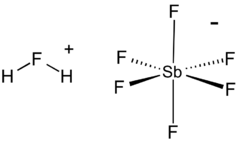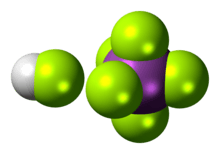Fluoroantimonic acid
Fluoroantimonic acid is an inorganic compound with the chemical formula H
2FSbF
6 (also written H
2F[SbF
6], 2HF·SbF5, or simply HF-SbF5). It is an extremely strong acid, easily qualifying as a superacid. The Hammett acidity function, H0, has been measured for different ratios of HF:SbF5. While the H0 of pure HF is −15, addition of just 1 mol % of SbF5 lowers it to around −20. However, further addition of SbF5 results in rapidly diminishing returns, with the H0 reaching −21 at 10 mol %. The use of an extremely weak base as indicator shows that the lowest attainable H0, even with > 50 mol % SbF5, is somewhere between −21 and −23.[1][2][3]
 | |
 | |
 | |
| Names | |
|---|---|
| IUPAC name
Fluoroantimonic acid | |
| Systematic IUPAC name
Fluoranium hexafluorostibanuide Fluoranium hexafluoridoantimonate(1−) | |
| Identifiers | |
| |
3D model (JSmol) |
|
| ChemSpider | |
| ECHA InfoCard | 100.037.279 |
| EC Number |
|
PubChem CID |
|
CompTox Dashboard (EPA) |
|
InChI
| |
| |
| Properties | |
| H 2SbF 6 | |
| Molar mass | 256.765
g/mol |
| Appearance | Colorless liquid |
| Density | 2.885 g/cm3 |
| Solubility | SO2ClF, SO2 |
| Hazards | |
| Main hazards | Extremely corrosive, Violent hydrolysis |
| GHS pictograms |     |
| GHS Signal word | Danger |
GHS hazard statements |
H300, H310, H314, H330, H411 |
GHS precautionary statements |
P260, P264, P273, P280, P284, P301+310 |
| NFPA 704 (fire diamond) | 
0
4
3 |
| Related compounds | |
Related acids |
Antimony pentafluoride Hydrogen fluoride |
Except where otherwise noted, data are given for materials in their standard state (at 25 °C [77 °F], 100 kPa). | |
| Infobox references | |
The "canonical" composition of fluoroantimonic acid is prepared by treating liquid hydrogen fluoride (HF) with liquid antimony pentafluoride (SbF5) in a stoichiometric ratio of 2:1. It is the strongest superacid based on measured H0 value. Only the carborane acids, whose H0 could not be directly determined due to their high melting points, may be stronger acids than fluoroantimonic acid.[4] It has been shown to protonate even hydrocarbons to afford pentacoordinate carbocations (carbonium ions).[5][6] It is exceptionally corrosive and can only be stored in containers lined with Teflon.
Fluoroantimonic acid thermally decomposes when heated, generating free hydrogen fluoride gas and liquid antimony pentafluoride. At temperatures as low as 40 C, fluoroantimonic acid will release HF into the gas phase. Antimony pentafluoride liquid can be recovered from fluoroantimonic acid by heating and releasing HF into the gas phase [7].
The reaction to produce fluoroantimonic acid results in formation of the fluoronium ion as a major species in equilibrium:
- SbF5 + 2 HF ⇄ SbF−
6 + H2F+
However, as noted below, the speciation of "fluoroantimonic acid" is complex, and consists of a mixture of HF-solvated protons, [(HF)nH]+ (e.g., H3F2+), and SbF5-adducts of fluoride (e.g., Sb4F21–). Thus, the formula "[H2F]+SbF6–" is a convenient but oversimplified approximation of the true composition.[8] Nevertheless, the extreme acidity of this mixture is evident from the exceptionally poor proton-accepting ability of the species present in solution (hydrogen fluoride, normally not thought to have any appreciable Brønsted basicity at all, is in fact the strongest Brønsted base in the mixture). As a result, the acid is often said to contain "naked protons", though the "free" protons are, in fact, always bonded to hydrogen fluoride molecules.[9] It is the fluoronium ion that accounts for fluoroantimonic acid's extreme acidity. The protons easily migrate through the solution, moving from H2F+ to HF, when present, by the Grotthuss mechanism:
- H2F+ + HF ⇌ HF + H2F+
Sources often confuse the H0 value of fluoroantimonic acid with its pKa. The H0 value measures the protonating ability of the bulk, liquid acid, and this value has been directly determined or estimated for various compositions of the mixture. The pKa on the other hand, measures the equilibrium of proton dissociation of a discrete chemical species when dissolved in a particular solvent. Since fluoroantimonic acid is not a single chemical species, its pKa value is not well-defined. The gas-phase acidity (GPA) of individual species present in the mixture have been calculated using density functional theory methods.[8] (Solution-phase pKas of these species can, in principle, be estimated by taking into account solvation energies, but do not appear to be reported in the literature as of 2019.) For example, the ion-pair [H2F]+•SbF6– was estimated to have a GPA of 254 kcal/mol. For comparison, the commonly encountered superacid triflic acid, TfOH, is a substantially weaker acid by this measure, with a GPA of 299 kcal/mol.[10] However, certain carborane superacids have GPAs lower than that of [H2F]+•SbF6–. For example, H(CHB11Cl11) has an experimentally determined GPA of 241 kcal/mol.[11]
Structure
Two related products have been crystallized from HF-SbF5 mixtures, and both have been analyzed by single crystal X-ray crystallography. These salts have the formulas [H
2F+
][Sb
2F−
11] and [H
3F+
2][Sb
2F−
11]. In both salts, the anion is Sb
2F−
11.[12] As mentioned above, SbF−
6 is weakly basic; the larger anion Sb
2F−
11 is expected to be still weaker.
The following values show that fluoroantimonic acid is much stronger than other superacids[4] based upon the Hammett acidity function. Increased acidity is indicated by smaller (in this case, more negative) values of H0.
- Fluoroantimonic acid (-23 < H0 < -21)
- Magic acid (H0 = −19.2)
- Carborane acid (H0 < −18)
- Fluorosulfuric acid (H0 = −15.1)
- Triflic acid (H0 = −14.9)
Applications
This extraordinarily strong acid protonates nearly all organic compounds, often causing dehydrogenation, or dehydration. In 1967, Bickel and Hogeveen showed that 2HF·SbF5 will remove H2 from isobutane and methane from neopentane to form carbenium ions:[13][14]
- (CH3)3CH + H+ → (CH3)3C+ + H2
- (CH3)4C + H+ → (CH3)3C+ + CH4
It is also used in the manufacture of tetraxenon gold compounds.
Materials compatible with fluoroantimonic acid as a solvent include SO2ClF, and sulfur dioxide; some chlorofluorocarbons have also been used. Containers for HF-SbF5 are made of PTFE.
Safety
HF-SbF5 is extremely corrosive, toxic, and moisture sensitive.[6] Like most strong acids, fluoroantimonic acid can react violently with water, owing to the exothermic hydration. Consequently, it cannot be used in aqueous solution, only in hydrogen fluoride as solvent.
Fluoroantimonic acid cannot be stored in glass, as it will dissolve it. It must be stored in a PTFE (polytetrafluoroethylene) container.[15]
See also
- Fluoroboric acid
- Fluorosulfuric acid
- Hexafluorophosphoric acid
References
- Superacid chemistry. Olah, George A. (George Andrew), 1927-2017., Olah, George A. (George Andrew), 1927-2017. (2nd ed.). Hoboken, N.J.: Wiley. 2009. ISBN 9780470421543. OCLC 391334955.CS1 maint: others (link)
- Olah, G. A. (2005). "Crossing Conventional Boundaries in Half a Century of Research". Journal of Organic Chemistry. 70 (7): 2413–2429. doi:10.1021/jo040285o. PMID 15787527.
- In ref. 2 (2005), Olah estimates that HF-SbF5 may reach H0 values as low as –28. On the other hand, in ref. 1 (2009), Olah cites one method that estimated H0 values down to –27 for FSO3H-SbF5 at 90% SbF5, but indicates that more reliable experimentally determined equilibrium constants do not support H0 values lower than about –24 for either magic acid or fluoroantimonic acid.
- Gillespie, R. J.; Peel, T. E. (1973-08-01). "Hammett acidity function for some superacid systems. II. Systems sulfuric acid-[fsa], potassium fluorosulfate-[fsa], [fsa]-sulfur trioxide, [fsa]-arsenic pentafluoride, [sfa]-antimony pentafluoride and [fsa]-antimony pentafluoride-sulfur trioxide". Journal of the American Chemical Society. 95 (16): 5173–5178. doi:10.1021/ja00797a013. ISSN 0002-7863.
- Olah, G. A. (2001). A Life of Magic Chemistry: Autobiographical Reflections of a Nobel Prize Winner. John Wiley and Sons. pp. 100–101. ISBN 978-0-471-15743-4.
- Olah, G. A.; Prakash, G. K. Surya; Wang, Qi; Li, Xing-ya (15 April 2001). "Hydrogen Fluoride-Antimony(V) Fluoride". Hydrogen Fluoride–Antimony(V) Fluoride. Encyclopedia of Reagents for Organic Synthesis. New York: John Wiley and Sons. doi:10.1002/047084289X.rh037m. ISBN 9780470842898.
- Oelderik, Jan (December 1966). "Werkwijze ter bereiding van halogeenverbindingen van vijfwaardig antimoon". Netherlands Patent Application. NL 6508096 A.
- Esteves, Pierre M.; Ramírez-Solís, Alejandro; Mota, Claudio J. A. (March 2002). "The Nature of Superacid Electrophilic Species in HF/SbF5: A Density Functional Theory Study". Journal of the American Chemical Society. 124 (11): 2672–2677. doi:10.1021/ja011151k. ISSN 0002-7863. PMID 11890818. no-break space character in
|title=at position 59 (help) - Klein, Michael L. (October 25, 2000). "Getting the Jump on Superacids" (PDF). Pittsburgh Supercomputing Center (PSC). Archived from the original (PDF) on May 31, 2012. Retrieved 2012-04-15.
- Koppel, Ilmar A.; Burk, Peeter; Koppel, Ivar; Leito, Ivo; Sonoda, Takaaki; Mishima, Masaaki (May 2000). "Gas-Phase Acidities of Some Neutral Brønsted Superacids: A DFT and ab Initio Study". Journal of the American Chemical Society. 122 (21): 5114–5124. doi:10.1021/ja0000753. ISSN 0002-7863.
- Meyer, Matthew M.; Wang, Xue-Bin; Reed, Christopher A.; Wang, Lai-Sheng; Kass, Steven R. (2009-12-23). "Investigating the Weak to Evaluate the Strong: An Experimental Determination of the Electron Binding Energy of Carborane Anions and the Gas phase Acidity of Carborane Acids". Journal of the American Chemical Society. 131 (50): 18050–18051. doi:10.1021/ja908964h. ISSN 0002-7863. PMID 19950932.
- Mootz, Dietrich; Bartmann, Klemens (March 1988). "The Fluoronium Ions H2F+ and H
3F+
2: Characterization by Crystal Structure Analysis". Angewandte Chemie International Edition. 27 (3): 391–392. doi:10.1002/anie.198803911. - Bickel, A. F.; Gaasbeek, C. J.; Hogeveen, H.; Oelderik, J. M.; Platteeuw, J. C. (1967). "Chemistry and spectroscopy in strongly acidic solutions: reversible reaction between aliphatic carbonium ions and hydrogen". Chemical Communications. 1967 (13): 634–635. doi:10.1039/C19670000634.
- Hogeveen, H.; Bickel, A. F. (1967). "Chemistry and spectroscopy in strongly acidic solutions: electrophilic substitution at alkane-carbon by protons". Chemical Communications. 1967 (13): 635–636. doi:10.1039/C19670000635.
- "What Is the World's Strongest Superacid?". ThoughtCo. Retrieved 2017-04-06.